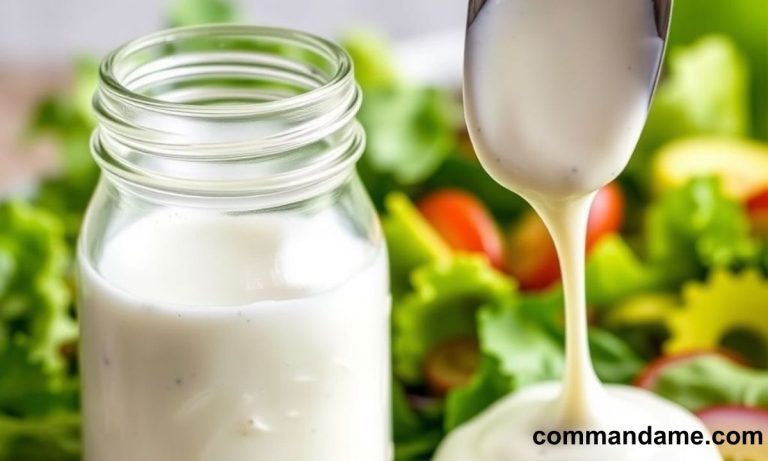Sage Butter Sauce: Elevate Your Dishes
Nothing elevates a dish like a nice sauce. I’m pleased to share sage butter sauce, one of my favorite sauces.
While in Italy, I found this sauce. The sage butter sauce made my basic gnocchi stand out. The soft, pillowy gnocchi went well with the rich, spicy, and slightly sweet sauce. I was instantly hooked and had to learn how to make it.
Since then, I’ve used sage butter sauce on roasted veggies and grilled meats. It always impresses me. Sage and buttery richness elevate a meal.
How to Make Sage Butter Sauce
One of my favorite condiments is sage butter sauce, and I’d like to share it with you. This condiment goes with just about anything and improves the flavor immensely. This sauce is delicious with anything from pasta to roasted veggies.
In this article, you will find detailed directions for making sage butter sauce, as well as answers to frequently asked questions and helpful hints for achieving the best possible results. Let’s dive in right now!
Sage Butter Sauce Ingredients
- 1/2 cup unsalted butter
- 12-15 fresh sage leaves
- 1/4 teaspoon salt
- 1/4 teaspoon black pepper
Instructions to Make Sage Butter Sauce
Melt the butter in a saucepan over medium heat.
Once the butter is melted, add the fresh sage leaves to the pan.
Cook the sage leaves in the butter until they become crispy and fragrant, about 3-4 minutes.
Remove the pan from the heat and let it cool for a few minutes.
Using a slotted spoon, remove the sage leaves from the butter and set them aside.
Pour the butter into a bowl, leaving any sediment at the bottom of the pan.
Add salt and pepper to taste, and stir the sauce until it is well combined.
Add the crispy sage leaves back into the sauce and stir.
Sage Butter Sauce Variations
Lemon Sage Butter Sauce: Add a squeeze of lemon juice to the sage butter sauce to make this variant. Lemon juice brightens and refreshes the sauce. This version complements seafood and fish.
This version is for garlic lovers. Add minced garlic to the melting butter and heat until fragrant before adding the sage leaves. Garlic compliments sage with its savory taste. It pairs well with pasta and roasted veggies.
Parmesan Sage Butter Sauce: Add freshly grated Parmesan cheese to sage butter sauce for this version. Sage’s herbaceousness complements the cheese’s saltiness and nuttiness. This variation is ideal for topping gnocchi or other pasta.
Mushroom Sage Butter Sauce: Sauté sliced mushrooms in butter before adding sage leaves for this version. Mushrooms will give the sauce a rich taste. It’s great on pasta or grilled meats.
What Goes Best With Sage Butter Sauce
Pasta: Sage butter sauce goes well with gnocchi, fettuccine, linguine, and ravioli. The creamy sauce makes pasta the ideal comfort food.
Roasted vegetables: Sage butter syrup flavors Brussels sprouts, sweet potatoes, and butternut squash. The sauce enhances the veggies’ sweetness and buttery richness.
Grilled poultry or pork chops with sage butter sauce. The rich sauce complements the broiled meat’s smokiness.
Salmon, prawns, and scallops can be topped with sage butter sauce. The herbaceous sauce complements the subtle seafood flavor.
Sage butter sauce can flavor pumpkin soup and poultry stew. The creamy gravy enhances the soup or stew’s hearty flavors.
Sage and Butter Sauce FAQs
Can I use dried sage instead of fresh sage?
While it is possible to use dried sage in this recipe, I highly recommend using fresh sage for the best flavor. Dried sage can be overpowering and may not provide the same depth of flavor as fresh sage.
Can I use salted butter instead of unsalted butter?
You can use salted butter, but I recommend using unsalted butter so that you can control the amount of salt in the sauce.
How long can I store sage butter sauce in the fridge?
Sage butter sauce can be stored in the fridge for up to one week. To reheat, simply melt the sauce in a saucepan over low heat and stir until it is warmed through.
Why Is My Butter Not Browning?
Several reasons may prevent the butter from browning. The butter may not be cooked hot enough.
Before adding butter, make sure the pan is hot. Another possibility is that you’re using margarine or low-fat butter.
These versions lack fat to brown. Finally, nonstick pans prevent the butter from adhering to the pan and heating up enough to brown.
What Does Brown Butter Sauce Taste Like?
Brown butter sauce has a nutty, caramelized flavor with hints of toffee and hazelnut. It’s rich, decadent, and has a slightly sweet flavor that pairs well with savory dishes.
Brown butter sauce is perfect for adding depth of flavor to dishes like pasta, vegetables, and meats. It’s also great for using as a dipping sauce for bread or drizzling over popcorn for a gourmet snack.
Ingredients Substitute For Sage Butter Sauce
Dried sage can substitute for fresh sage. Dried sage has a stronger taste, so use half as much as fresh. If you prefer, use thyme, rosemary, or oregano instead of sage.
Olive oil, coconut oil, or ghee are better butter substitutes. The sauce may taste and feel different, but it will still be wonderful.
Vegan Substitute: If you’re vegan, use vegan butter or coconut milk instead of butter. Cashew cream or almond milk adds a rich flavor.
Gluten-free substitute: Rice flour or cornflour can thicken the gravy if you’re gluten-free. Serve the gravy with gluten-free pasta or rice.

Sage Butter Sauce
Equipment
- Skillet
- Wooden spoon
Ingredients
- 1/2 cup unsalted butter
- 12-15 fresh sage leaves
- 1/4 teaspoon salt
- 1/4 teaspoon black pepper
Instructions
- Melt the butter in a saucepan over medium heat.
- Once the butter is melted, add the fresh sage leaves to the pan.
- Cook the sage leaves in the butter until they become crispy and fragrant, about 3-4 minutes.
- Remove the pan from the heat and let it cool for a few minutes.
- Using a slotted spoon, remove the sage leaves from the butter and set them aside.
- Pour the butter into a bowl, leaving any sediment at the bottom of the pan.
- Add salt and pepper to taste, and stir the sauce until it is well combined.
- Add the crispy sage leaves back into the sauce and stir.
Notes
- Be sure to use fresh sage leaves for the best flavor.
- Keep an eye on the sage leaves as they cook in the butter, as they can burn easily.
- Try adding other herbs and spices to the sauce, such as garlic or lemon zest, to add more depth of flavor.
- Use the sauce to top pasta dishes, roasted vegetables, or meats.






